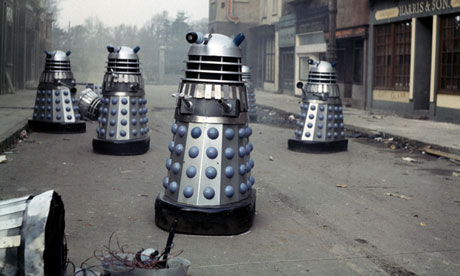Daleks are a legacy of British pop art
The Doctor Who menace designed by the late Raymond Cusick is a kind of kitchen sink sci-fi, at once absurd and marvellous

Ironic juxtaposition of real and unreal … the Daleks at work. Photograph: Ronald Grant Archive
The Daleks are a masterpiece of pop art. The death of their designerRaymond Cusick is rightly national news: it was Cusick who in the early 1960s gave a visual shape to this new monster invented by Doctor Whowriter Terry Nation. But in the 50th anniversary of Britain's greatest television show, the Daleks need to be seen in historical perspective. It is all too tempting to imagine Cusick and Nation sitting in the BBC canteen looking at a pepper pot on their lunch table and realising it could be a terrifying alien cyborg. In reality, the Daleks are a living legacy of the British pop art movement.
With Roy Lichtenstein whaaming 'em at London's Tate Modern, it is all too easy to forget that pop art began in Britain – and our version of it started as science fiction. When Eduardo Paolozzi made his collage Dr Pepper in 1948, he was not portraying the real lives of austerity-burdened postwar Britons. He was imagining a future world of impossible consumer excess – a world that already existed in America, whose cultural icons from flash cars to electric cookers populate his collage of magazine clippings. But that seemed very far from reality in war-wounded Europe. Pop art began as an ironically utopian futuristic fantasy by British artists trapped in a monochrome reality.
The exhibition that brought pop art to a wider audience was This Is Tomorrow at the Whitechapel Gallery in 1956. As its title implies, This Is Tomorrow presented pop as visual sci-fi. It included a poster for the science fiction film Forbidden Planet and was officially opened by the star of the film, Robbie the Robot.
The layout of This Is Tomorrow created a futuristic landscape from fragments of found material and imagery, just as Doctor Who would fabricate alien worlds from silver foil and plastic bottles. The reason the series would face a crisis by the end of the 1970s was that its effects were deemed old-fashioned compared with Star Wars: but the whole point of Dr Who was that it demanded imagination of its audience and presented not fetishised perfect illusions, but a kind of kitchen sink sci-fi that shared the playfulness of pop art.
The Daleks are a wonder of pop art's fantastic vision, at once absurd and marvellous. Most of all, they share the ironic juxtaposition of real and unreal one finds in the art of Richard Hamilton. Like a Hoover collaged into an ideal home, the Daleks are at their best gliding through an unexpected setting such as central London – a metal menace invading homely old Britain.
No comments:
Post a Comment